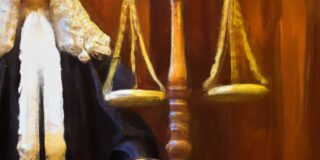
In the intricate landscape of governance, the latent potential of legal frameworks often lies dormant, appearing innocuous during periods of relative stability. These frameworks, meticulously crafted to provide order and structure, can serve as both a shield and a weapon in the hands of sovereign entities – whether they be individuals, factions, or ideologies. As political circumstances shift, this potential can be awakened, enabling these entities to seize authority and reshape nations according to their agendas.
While such manoeuvres may seem effective for consolidating power, they carry profound and far-reaching consequences that warrant careful examination. The stark reality is this: to maintain control over a nation, particularly in the face of dissent, an increasing number of voices must be silenced and marginalised. This dynamic reveals a fundamental truth about governance: the imperial model, characterised by its emphasis on centralised authority and repression, emerges as a paradigm for managing mass opposition.
Political systems that rely on the suppression of substantial segments of their populace are invariably doomed to a predictable fate. The mechanisms of control, designed to maintain the status quo and uphold the ruling power, ultimately consume the very system they are intended to support. This phenomenon is not merely a historical pattern; it is an almost inevitable law of political nature, akin to an elegant yet brutal truth.
The implications of this discourse extend beyond theoretical musings; they resonate deeply within the fabric of contemporary society. A nation that denies its highest ideals to some will ultimately forfeit them for all. This is not merely a cautionary tale but a clarion call to recognise the interconnectedness of governance and the human experience. When a state chooses to marginalise certain groups, it does not merely silence dissent; it undermines the very principles of justice, equality, and liberty that form the bedrock of a flourishing society.
Moreover, the awakening of legal frameworks to serve the interests of a select few often leads to a fracturing of societal cohesion. When governance is predicated on exclusion and repression, the bonds that hold a nation together begin to erode. Citizens become disillusioned, and the legitimacy of authority wanes. What was once viewed as a stabilising force can quickly devolve into chaos as the marginalised rise to reclaim their voices and assert their rights.
In this light, the pursuit of power through legalistic manipulation and repression is not only morally questionable but also strategically flawed. The history of governance teaches us that the most resilient systems are those that embrace inclusivity, foster dialogue, and uphold the ideals of justice for all. It is through the recognition of our shared humanity and the commitment to protect the rights of every individual that we can build a robust and enduring political framework.
The Dormant Potential of Legal Infrastructure
Legal systems are inherently designed with a degree of flexibility, embedding mechanisms that may remain dormant during stable times but can be reactivated when power seeks to assert itself. While this adaptability is theoretically a strength, it transforms into a vulnerability in practice. Sovereign entities – whether monarchs, dictators, or oligarchic elites – can exploit these dormant tools to consolidate authority. Historical precedents abound, such as the transformation of the Roman Republic into the Empire under Augustus, which relied on existing legal frameworks to centralise control. Similarly, contemporary states have witnessed the revival of dormant emergency powers or obscure statutes to justify authoritarian measures, such as the invocation of anti-sedition laws in democratic nations confronting unrest.
The reactivation of such infrastructure is not a neutral act; it necessitates a deliberate choice to prioritise the interests of the sovereign over those of the broader populace. This process is rarely subtle; it requires the identification of enemies, real or imagined, whose exclusion becomes the rationale for tightening control. The legal framework, once a bastion for justice, morphs into a weapon of oppression, wielded to entrench power rather than distribute it equitably.
Repression as a Prerequisite for Control
To govern a nation according to a singular vision, dissent must be neutralised. This necessitates the disenfranchisement of those who resist – whether through exclusion from political participation, suppression of speech, or outright violence. The more ambitious the sovereign’s agenda, the broader the swath of the population that must be silenced. This escalation is not merely a byproduct of ambition; it is a structural requirement of authoritarian governance. The imperial model, exemplified by figures such as Napoleon or the colonial administrators of the British Empire, demonstrates this clearly. Authority is maintained not through consensus but through the systematic marginalisation of entire classes, ethnic groups, or ideologies.
Take, for instance, the case of colonial governance: empires such as Britain’s ruled vast territories by disenfranchising native populations, employing legal codes that privileged settlers and repressed indigenous dissent. The Indian Penal Code of 1860, for example, included provisions like Section 124A (sedition), explicitly designed to stifle resistance to British rule. This pattern recurs across contexts – authority expands by constricting the circle of those who wield it, a process that accelerates as dissent grows.
The Imperial Prototype and Its Inevitability
The imperial form of governance emerges as the prototype for exerting control amid mass dissent because it is uniquely suited to the task. It prioritises hierarchy over equity, coercion over cooperation, and unity of purpose over plurality of voices. Yet this apparent strength is also its fatal flaw. Systems that suppress significant portions of their population cannot sustain themselves without the mechanisms of repression becoming the defining feature of the state. The tools of control – secret police, propaganda, restrictive laws – begin as instruments of the sovereign but soon overtake the system, dictating its priorities and character.
This dynamic resembles a law of nature: just as entropy increases in a closed system, so too does repression expand within a political structure that embraces it. The Soviet Union serves as a stark illustration. Initially founded on ideals of equality, it devolved into a state where the mechanisms of control – the KGB, gulags, and censorship – dominated every facet of governance, eclipsing the revolutionary vision they were meant to serve. The elegance of this progression lies in its simplicity: power, once concentrated, demands ever more power to sustain itself, until the system becomes a caricature of its original intent.
The Universal Cost of Selective Ideals
The final and perhaps most profound consequence of this process is the erosion of a nation’s ideals. A state that withholds its best principles – liberty, justice, equality – from some of its people cannot preserve them indefinitely for others. This is not merely a moral admonition but a practical reality. When repression becomes systemic, it ceases to discriminate; the tools honed against the marginalised are eventually turned inward. The United States’ history of slavery and segregation exemplifies this. The denial of rights to African Americans necessitated a legal and cultural framework that, over time, corroded democratic norms for all, as seen in the suppression of dissent during the Red Scare or the surveillance state post-9/11.
A nation’s ideals are not divisible. They either apply universally or erode universally. When some are excluded from the promise of justice, the concept itself weakens, leaving the state vulnerable to the very authoritarianism it once claimed to oppose. This loss is not sudden but cumulative, a slow unraveling that mirrors the expansion of repression itself.
Historical Examples Supporting my Thesis
Legal Capture and Repression from the Roman Republic to Modern Times
The narrative of history is often punctuated by the rise and fall of empires, governments, and systems of governance. A recurring theme throughout these transitions is the reactivation and repurposing of dormant legal infrastructures to consolidate power, often at the expense of the very ideals that those systems purported to uphold. This post delves into historical examples that illustrate this phenomenon, focusing on the Roman Republic’s transformation into the Empire, British colonial rule in India, the Soviet Union, the United States, and Nazi Germany. Each case exemplifies how legal frameworks can be manipulated to suppress dissent and erode democratic ideals, ultimately leading to the systemic repression of populations.
The Roman Republic to Empire: Legal Capture and Repression
The transition from the Roman Republic to the Empire under Augustus serves as a foundational example of how existing legal mechanisms can be exploited to centralise power. The Republic’s legal framework included provisions like the dictatura, a temporary office designed to grant extraordinary powers to a single leader during times of crisis. Although intended as a safeguard, this office lay dormant until leaders like Julius Caesar and Augustus recognised its potential for consolidating authority. Augustus cleverly styled himself as the Princeps, or First Citizen, repurposing institutions such as the Senate and consular authority to centralise control without formally abolishing the Republic.
In this context, dissent was met with brutal repression. Senators who opposed Augustus faced exile or execution, and the Lex Julia Maiestatis, a treason law, was expanded to criminalise any criticism of the emperor. This created an environment where political rivals were systematically disenfranchised and public dissent was silenced. As Augustus’s successors took the throne, the trend of repression intensified, with the Praetorian Guard evolving from protectors to enforcers of autocratic rule. By the 3rd century CE, the emperor had transitioned from a civic leader to a divine autocrat, prioritising control over the Republic’s ideals of liberty and shared governance.
The British Empire in India: Imperial Governance and Systemic Repression
The British colonial administration in India from 1858 to 1947 illustrates the imperial prototype in action, showcasing how legal infrastructures were employed to suppress mass dissent. Following the 1857 Sepoy Mutiny, the British Crown assumed direct control, reactivating and expanding legal tools from the East India Company era. The Indian Penal Code of 1860 and the Code of Criminal Procedure of 1861 introduced provisions like Section 124A, which criminalised sedition – any act “exciting disaffection” against the government.
These laws, dormant during peacetime, were readily weaponised during periods of unrest, as exemplified by the 1919 Jallianwala Bagh massacre, where peaceful protesters were brutally killed under martial law. Repression was essential for maintaining British sovereignty, with entire communities – especially those involved in nationalist movements – facing censorship, mass arrests, and land confiscation. The Rowlatt Act of 1919 further entrenched this repression by allowing for indefinite detention without trial, targeting dissenters like Mahatma Gandhi. The colonial governance model increasingly relied on a repressive apparatus that overshadowed any claims to a civilising mission, ultimately hollowing out the ideals of justice and liberty that Britain championed at home.
The Soviet Union: Repression Overtaking the System
The Soviet Union, established in 1922, began with revolutionary ideals of equality and collective ownership but quickly illustrates how repressive mechanisms can overpower a system. The Bolsheviks inherited legal tools from the Tsarist regime, such as internal exile and secret police, and reactivated them to consolidate power. Lenin’s Decree on Press in 1917 shut down opposition media, while the 1922 Criminal Code criminalised “counter-revolutionary” activity, a vague charge that became a tool for repressing dissenters.
As Joseph Stalin rose to power, repression intensified in response to growing resistance. The Great Purge from 1936 to 1938 resulted in millions being arrested, executed, or sent to labor camps, effectively disenfranchising entire social classes. While the Soviet state initially aimed to promote equality, by the 1950s, it was defined by its repressive machinery – censorship, surveillance, and the gulag system. This transformation demonstrated that withholding ideals from perceived “enemies of the state” ultimately stripped those ideals from everyone, creating an environment of suspicion even among loyal citizens.
The United States: Slavery, Segregation, and the Erosion of Democratic Ideals
The United States presents a domestic example of how the denial of ideals to certain populations undermines them for all. The Constitution, ratified in 1787, contained dormant clauses such as the Fugitive Slave Clause and the Three-Fifths Compromise, which entrenched slavery. The Fugitive Slave Act of 1850 reactivated these clauses, leading to the repression of enslaved people and their allies through laws that prohibited literacy and assembly.
Post-Civil War, the Jim Crow laws reactivated this framework, disenfranchising Black Americans through poll taxes, literacy tests, and violent intimidation. The imperial model here is racial, with control requiring the subjugation of a significant portion of the population. Over time, these mechanisms of repression permeated broader governance, as seen in McCarthyism during the 1950s and the post-9/11 Patriot Act, which echoed earlier surveillance laws. The denial of “liberty and justice for all” to Black Americans weakened these ideals for everyone, culminating in mass incarceration and the erosion of civil liberties that persist today.
Nazi Germany: Total Repression and Collapse
Nazi Germany offers a stark illustration of legal capture and total repression overtaking a system. The Weimar Constitution included Article 48, which allowed for emergency decrees – a dormant tool until Hitler’s Enabling Act of 1933 reactivated it to suspend rights and dissolve opposition. The Nazi regime systematically repressed Jews, Romani people, communists, and others, disenfranchising millions through the Nuremberg Laws and the establishment of concentration camps.
The repressive apparatus, including the Gestapo and the SS, soon became the defining characteristic of the state, overshadowing any economic or cultural aspirations. By 1945, the ideals of national unity and progress had been obliterated, consumed by a regime that terrorised even its own citizens. The total collapse of Nazi Germany underscores the thesis that a system built on subjugation cannot endure without ultimately destroying itself and its principles.
Analysis Across Examples
The historical examples outlined above reveal consistent patterns in the reactivation of legal frameworks for the purpose of consolidating power and repressing dissent:
Reactivation and Capture: Dormant legal tools were repurposed to entrench authority (e.g., Roman dictatura, British sedition laws, Weimar’s Article 48).
Repression’s Escalation: Control necessitated the disenfranchisement of growing segments of the population (e.g., Roman senators, Indian nationalists, Soviet kulaks, Black Americans, German Jews), with repression intensifying in response to dissent.
Imperial Prototype: Each system adopted centralised, hierarchical governance models to manage opposition, reflecting imperial logic.
Mechanisms Overtaking the System: Repressive tools became the core of state identity, sidelining original ideals and intentions.
Loss of Ideals for All: The erosion of liberty, justice, equality, and unity occurred universally as repression expanded, ultimately undermining the very foundations of each respective system.
Modern Examples Supporting my Thesis
Russia Under Putin: Legal Capture and Expanding Repression
Since Vladimir Putin’s ascent to power in the early 2000s, Russia has witnessed a profound transformation characterised by the reactivation of dormant Soviet-era legal mechanisms aimed at consolidating authority and suppressing dissent. This shift represents not merely a political manoeuvre but a systematic legal capture that has redefined the landscape of governance in Russia.
The 1993 Russian Constitution, which ostensibly upholds democratic principles, contains provisions such as Article 81, designed to limit presidential terms. However, these constitutional safeguards were effectively circumvented through amendments in 2020, allowing Putin to extend his rule indefinitely. Such legal gymnastics highlight a broader trend in which laws originally intended to safeguard democracy are repurposed to entrench authoritarianism.
One of the most alarming developments has been the weaponisation of legislation to stifle opposition. The 2012 “Foreign Agents” law, initially aimed at foreign influence, has been expanded to target non-governmental organisations (NGOs) and independent media. In 2021, the government further broadened the scope of “undesirable organisations,” transforming these once minor regulatory tools into instruments of repression. High-profile opposition figures, such as Alexei Navalny, have faced brutal crackdowns, with Navalny tragically dying in prison in 2024 under suspicious circumstances, underscoring the dire state of human rights in the country.
The escalation of repression has intensified, particularly following the invasion of Ukraine in 2022. Protests against the war have been met with swift and brutal responses, resulting in mass arrests under vague “public order” laws, with over 20,000 detentions reported in 2022 alone. This response reflects a broader imperial model of governance, characterised by a centralised and hierarchical structure reminiscent of Tsarist autocracy. The Federal Security Service (FSB), the modern successor to the KGB, has become the backbone of this repressive regime, enforcing censorship, imprisoning critics like Vladimir Kara-Murza, and even targeting individuals within the regime suspected of disloyalty.
What was once a unifying narrative of sovereignty and national pride has eroded into a hollow nationalism. The Russian populace now faces an environment of pervasive surveillance and compulsory conscription, illustrating a grim reality: the withholding of freedom from a select few ultimately diminishes it for all. The repressive measures employed by the state have not only stifled dissent but have also fostered a culture of fear that permeates society.
Global Reflections: China, Turkey, and India
The situation in Russia mirrors similar trends observed globally, where dormant legal frameworks are reactivated to bolster authoritarian control. In China, for instance, Xi Jinping has modernised Maoist-era mechanisms of mass surveillance and ideological conformity, exemplified by the 2014 Social Credit System. Initially designed for financial oversight, this system has morphed into a comprehensive apparatus for tracking behavior and punishing dissent, particularly against marginalised groups like the Uyghur Muslims in Xinjiang. The Chinese government employs vague anti-terror laws to justify the mass internment of over one million Uyghurs in “re-education” camps, revealing the chilling extent of state power.
Turkey under Recep Tayyip Erdo?an provides another stark example of legal capture and repression. Following the 2016 coup attempt, Erdo?an reactivated emergency powers that led to the purging of over 130,000 public servants and the imprisonment of thousands, including journalists and political opponents. The judiciary, once a bulwark against tyranny, has been transformed into a tool of repression, with constitutional amendments effectively neutralising its independence. The recent elections in Turkey were marred by arrests and media blackouts, underscoring the extent of Erdo?an’s authoritarian drift.
Even in the United States, the post-9/11 landscape reveals a troubling reactivation of dormant legal infrastructures, particularly through the 2001 Patriot Act. Originally intended to combat terrorism, these expanded surveillance powers have increasingly targeted domestic dissent, with climate activists and social justice movements coming under scrutiny. The militarisation of policing, rooted in the “war on drugs,” disproportionately impacts marginalised communities, perpetuating a cycle of repression that undermines the ideals of liberty and justice for all.
India’s Narendra Modi has similarly harnessed legal tools to advance a Hindu nationalist agenda, utilising laws like the Unlawful Activities (Prevention) Act (UAPA) to target dissenters and marginalised groups, particularly Muslims. The Citizenship Amendment Act (CAA) and the National Register of Citizens (NRC) further disenfranchise Muslim communities, leading to widespread protests met with brutal police responses. The erosion of secularism and pluralism in India reflects a broader trend where the ideals of democracy are increasingly withheld from certain segments of society.
Conclusion
The imperial model of governance, historically employed to maintain control and quell dissent, illustrates a universal truth: systems predicated on subjugation cannot endure without being ultimately consumed by their own mechanisms of control. This is not merely a contingent outcome; rather, it is an almost elegant law of political nature, wherein the very structures that are intended to enforce order and compliance become the harbingers of instability and chaos. The cyclical nature of oppression and resistance manifests itself in societies across the globe, reminding us that the threads of power woven through legal systems can easily unravel when they are used to suppress rather than uplift.
At the heart of this discourse lies a profound moral imperative: a nation that denies its highest ideals to a portion of its populace risks losing those very ideals for all. This is a cost that extends beyond the oppressed; it also ensnares the oppressors in a web of moral and ethical decay. When a society chooses to disregard its foundational principles of equality, justice, and human dignity, it not only betrays its most vulnerable citizens but also undermines the legitimacy of its own authority. The erosion of these ideals can lead to a pervasive disillusionment that engulfs the entire social fabric, threatening the stability and coherence of the state itself.
In recognising this precarious balance, we are confronted with both a warning and a challenge. The specter of dormant tyrannies looms large, urging us to remain vigilant against the reactivation of oppressive systems that lie in wait. The historical lessons of empires that have crumbled under the weight of their own tyranny serve as stark reminders of the consequences that arise when governance becomes synonymous with repression. It is imperative for contemporary societies to foster an environment where legal frameworks are utilised as instruments of liberation rather than tools of oppression.
Thus, the onus falls upon us – citizens, leaders, and advocates alike – to resist the allure of authoritarianism that can so easily seep into the cracks of our legal institutions. We must actively engage in the cultivation of a political culture that prioritises inclusivity, accountability, and justice. By doing so, we not only honor the ideals that define our humanity but also safeguard the very foundations of our governance from the corrosive effects of tyranny.


